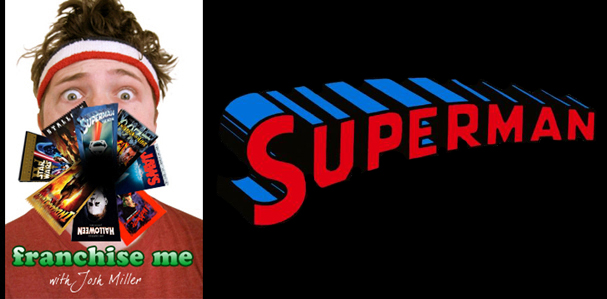
Hollywood loves a good franchise. The movie-going public does too. Horror, action, comedy, sci-fi, western, no genre is safe. And any film, no matter how seemingly stand-alone, conclusive, or inappropriate to sequel, could generate an expansive franchise. They are legion. We are surrounded. But a champion has risen from the rabble to defend us. Me. I have donned my sweats and taken up cinema’s gauntlet. Don’t try this at home. I am a professional.
Let’s be buddies on the Facebookz!
The Franchise: Superman: following the peacekeeping exploits of super-powered alien Kal-El, who was sent to Earth moments before his home-planet exploded, and was then subsequently raised by middle-American farmers under the name of Clark Kent. Created by writer Jerry Siegel and artist Joe Shuster as a comic book character, the franchise has expanded into pretty much every single conceivable medium, spanning from 1938 to the present. For our purposes here, we’ll only be examining the theatrically released live-action films.
previous installments
Superman (1948)
Atom Man vs Superman
Superman and the Mole Men
Superman (1978)
Superman II
Superman III
Supergirl
Superman IV: The Quest for Peace
Superman Returns
The Installment: Man of Steel (2013)
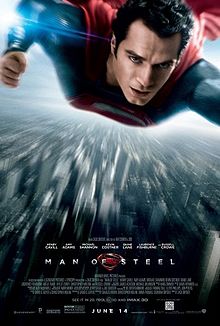
The Story:
Poor Krypton. Yet again the universe’s most frequently exploding planet is in trouble. And yet again only wizened Jor-El (Russell Crowe) believes it. But exploding couldn’t come at a better time, since General Zod (Michael Shannon) was already staging a violent coup anyhow. So Jor gets his baby, Kal-El, off the planet just before things go kablooey. Pa and Ma Kent (Kevin Costner, Diane Lane) take in the baby, until he is old enough to go on a David Banner-esque journey of discovery, helping oil workers, giving comeuppance to dickhead truckers, meeting plucky reporter Lois Lane (Amy Adams), and slowly forming into Superman (Henry Cavill). Then Zod re-enters the picture to fuck Earth up. Not to be outdone on his home turf, Superman also fucks Earth up until Zod learns who’s boss.
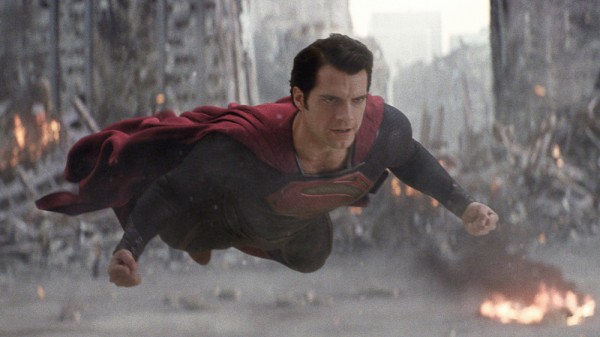
What Works:
If you’re following these Superman films, I’m gonna go out on a limb and say that your feelings for Man of Steel are probably contrastingly proportional, if not directly inverse to your feelings for Superman Returns. That seems like a safe assumption, given that Man of Steel almost feels like a reaction to Superman Returns. And in a sense, it probably was. While I still genuinely believe that the conceptual intent of Returns could have been something special, the film nonetheless provides fodder for the argument that you should never look backwards in a franchise the way Bryan Singer did. So in the wake of the mammoth critical and cultural success of Christopher Nolan’s first two Batman films, Warner Bros surely felt they needed to put a similar new stamp on Ol’ Supes. It is as though Warner Bros re-watched Returns and then set out to do the exact opposite at every turn: “Superman didn’t fight enough for ya, huh? Boom! Now he fights FOREVER.” Man of Steel and Superman Returns form an aesthetic yin and yang of cinematic-experience — one film’s weakness being the other’s strength. Returns had soul but lacked spirit. Man of Steel lacks soul, but it has spirit in goddamn spades.
Man of Steel is an aggravatingly flawed film. I found it simultaneously invigorating and horrible. But it did leave an impression on me — something the franchise hadn’t truly done in a meaningful way since Superman II. There is an excitement to the film, and most of that came from the feeling that I was seeing something new in a story that I am now very familiar with. Of course, novelty can prove to be fleeting, but that is chatter for the next section. Let’s be positive for now…
Step one with this film was the Nolan-ization of Superman. Warner Bros needed/wanted Man of Steel to do for Supes what Batman Begins had done for Batman (now with the hindsight-power they lacked in 2006 for Returns), while clearly also wanting to lay the groundwork for a crossover cinematic universe comparable to what Marvel Studios had done. For WB, this logically meant putting Christopher Nolan (and writer David Goyer) up as the artistic figurehead of the DC Cinema Universe. So Superman needed to be darker and more grounded, connecting the dots and adding quasi-logic to the parts of the mythology that may seem too “comicbook-y.” This wasn’t heavy lifting with Batman, given the reasonable nature of the character’s world; it mostly meant curbing or re-thinking Batman’s rogues gallery for the films. Superman is a different story. The dude is a flying alien Jesus who can shoot heat lasers out of his eyes. The Nolan-ization can only go so far before stripping away the very identity of Superman. Richard Donner’s Superman was so true to the existing character – and so influential itself – that we have all been living with the same (cinematic) idea of Superman and his world for a very long time. So, in theory at least, the idea of Nolan-izing the Son of Krypton’s world does intrigue me.
When changing a property there is always the risk that you’ll offend longtime fans, but as someone who was first exposed to Batman through Tim Burton’s outside-the-box Batman, I know Warners Bros was far more concerned with minting new fans than they were with appeasing existing fans. There is a fuzzy yet real line between innovation and disrespect — which is something Nolan, Goyer and director Zack Snyder have since been accused of by Superman fans. Ang Lee made a wonky Hulk film because at the end of the day he thought his source material was kind of silly. I don’t believe Snyder or Nolan or Goyer think Superman is silly. Though they do dance the line at times. For example, instead of Kal-El using a glowing Kryptonian crystal left in his space-cradle to build a giant ice fortress at the North Pole so he can talk to Jor-El, he uses a Kryptonian flash drive left in his space-cradle to re-activate a giant spaceship he finds buried in the arctic ice so he can talk to Jor-El. That does feel like a lack of faith in the archetypes of the mythology, but the way it fits into the story works — with the buried spaceship being the catalyst for Lois discovering Superman, and with Superman’s activation of the craft allowing Zod to find Earth (which has the nice tragic drama of Kal-El simultaneously unlocking his past and potentially dooming his future). The Nolan aesthetic is about emphasis on character, and making us relate to a hero that we ostensibly should not be able to relate to (e.g., an angry billionaire or a god-like alien). So I suppose, inevitably, the most successesful areas of Nolan-ization in Man of Steel are the areas that have less to do with tweaking the mythology and more to do with fleshing out character…
Donner’s Smallville was an idealized Norman Rockwell world of rich colors and yesteryear vibes — itself as much of a never-was fantasy as Krypton. Man of Steel gives us the midwest of the world we all live in. This makes Clark come off more as an X-Men character than a fantastically perfect superbeing. Now we focus less on Clark being an unpopular nerd who has to hide his powers, and more on him as an outsider because of his powers. To contrast, look at the bully scenes from Man of Steel versus Donner’s Superman. In Man of Steel, Young Clark doesn’t fight back when bullies physically attack him. In Superman, Young Clark resists the urge to stand-up to and show off in front of bullies who verbally harass him on the football field. Donner’s Young Clark is frustrated because he can’t let the jocks (or rather the girls who hang with the jocks) know how cool he really is. He isn’t allowed to shine. Man of Steel’s Young Clark doesn’t seem to care about shining. He just wants to be normal. It is a subtle yet major tonal difference. In Man of Steel, after Young Clark’s bullies leave, Kevin Costner’s Pa asks him, “Did they hurt you?” Clark responds,“You know they can’t” Pa says, “That’s not what I meant.” Team Nolan wants us to view Superman as a real person, not an archetype. Which means we need to understand him. And this is the area where Nolan and Goyer connect with the material. I thought the most compelling portions of Batman Begins were seeing how Bruce Wayne became Batman. Similarly here, I found Clark’s oddjob, reluctant-hero walkabout the most interesting and fulfilling section of Man of Steel — this is the Superman we’ve yet to see on the big screen. Donner skipped past Clark becoming Superman, and though I don’t think that hurt his film at all, it nonetheless created an inherent disconnect by not showing us Kal-El’s evolution into a superhero.
I think Lois Lane too benefits from her Nolan-ization. While I love the plucky, often scatterbrained Lois we had in the past, Man of Steel is the first film to truly utilize the fact that Lois is a hotshot reporter. In Superman Returns Lois could have had any job for the story to work. It was only out of tradition that she was a reporter. In Donner’s film, Superman woos Lois, allowing her to interview him once he is already famous. She could have hosted an E! show and still had the same story. So it is a relevant change to have Lois uncover Superman before anyone else does and for their relationship to begin in secret instead of in front of all the world to see (or read about). I only wish this portion of the film could have lasted longer.
Okay, now we have a script that has made strides to generate a “new” Superman. If you want to separate your Superman movie from Richard Donner even further, hiring someone like Zack Snyder is a logical next move. Once Snyder was announced for Man of Steel I knew that even if the film turned out to be hot garbage, snarky fans were never going to labeled it: “Superman lifts things” (as befell Superman Returns). Admittedly, Snyder is a director I have mixed feelings about. I respected the directorial craft and control on display in 300 and Watchmen, but, for my tastes, Dawn of the Dead is the only one of his films where the story and the style feel balanced. But his baroque approach to action is well suited for a character as grandiose in scale as Superman. And Snyder delivers on this expectation. In a previous article, I flippantly said that I wanted Superman to “punch things.” Well, here we be! Man of Steel steams with macho vitality. If Richard Donner showed us the majesty of Superman, Snyder shows us Superman’s magnitude. We’ve seen Superman do astounding things before, but they were things spectators cheered on from the sidewalk. This is the first time you feel like spectators should run for fucking cover anytime Superman shows up. Snyder’s Superman is no cartoon, floating through the air and bending girders around burglars. He is a demigod of raw, violent, and terrifying power — and 21st-century special FX allow Snyder to provide all the dust, shock impacts, and subtle (to not so subtle) collateral damage that a outsized creature like Superman would reasonably have on our shitty planet. It says everything you need to know about Snyder’s vision of Superman that this Kal-El needs to tell bystanders not to stand close to him when he’s about to fly. This Superman does not ascend into the air. He blasts off. He is a berserker doom machine.
More than anything else, Snyder is responsible for the film’s “spirit.” There is a reckless abandon in Synder’s treatment of Superman. He is like a teen who got a chance to drive his dad’s sports car, and immediately sets out to put the vehicle through everything that the family station wagon could never handle. He may not live through the night, but dammit he is gonna go fucking crazy while he can. And though I didn’t always like where Snyder’s joyride was taking me, I couldn’t help but feel exhilarated with the wind in my hair. That is a testament to Snyder’s assured directorial hand. You can claim that maybe Snyder didn’t understand the traditional form of Superman, but I don’t think he failed to understand what is stimulating about the character. Despite my better judgement, I was thrilled when Superman first grabs Zod and kamikazes his way into Smallville. I’m just not used to seeing Superman fuck shit up like that. Snyder has a knack for portraying any moment with the utmost intensity. This is a world where a light bulb can burst off and then somehow burst back on again moments later. Why? Cause it is more exciting that way! But Snyder isn’t only hollow boom-pow, or Michael Bay “ooo coool!” dolly shots. He knows he needs to give the character service. And he has put together a worthy Superman; something the past history of this franchise has shown us is not an easy task…
Christopher Reeve looked like he walked right off the pages of a DC comic. Unlike poor Brandon Routh, Henry Cavill is freed up from the impossible task of replicating Reeve. Cavill doesn’t remind me of the comic character at all, but he snuggly fits what Snyder is trying to do with the character. I can’t really imagine Reeve’s Superman pulling off a beard. But I was a little bummed once Cavill shaved off his face-shag. This Superman is definitely a Super-man — with Snyder’s male-body-fetish in full effect. In the past, the first big shot of Superman being ‘super’ has always been him in full costume, wooshing through the air. In Man of Steel we get a damp, shirtless and abb-tacular Superman licked by flames in the hallway of an oil rig. Superman went from being dreamboat-y to a sexy beast. I’m not saying that is an improvement or a detraction. It is just a new Superman.
The film has a very solid cast, mostly across the board. Dylan Sprayberry and Cooper Timberline are both good as Young Clark; especially Sprayberry as the angrier Teen Clark. I didn’t think I would like Diane Lane and Kevin Costner in their roles of Ma and Pa Kent, but I ended up liking them a lot. Costner in particular brings a lot of heartland authenticity to Jonathan Kent, simply by standing there and being Kevin Costner. And the scene in which Diane Lane is ‘talking down’ a young Clark after he’s locked himself in a closet at school is one of the film’s few successful emotional moments. Amy Adams is a really great choice for Lois Lane; she’s probably the most plausible casting for a successful journalist we’ve seen yet. And though I ultimately did not like the character of General Zod, credit where it is due — Michael Shannon is a fabulous choice to walk in Terrence Stamp’s demented boots. Shannon brought what he should to Zod. No one seethes with rage or bubbles with unhinged instability quite like Shannon does.
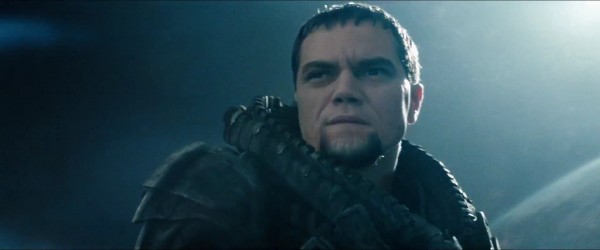
What Doesn’t Work:
As I said, Man of Steel is aggravatingly flawed. I say “aggravatingly” because I think it came so very close to being a great film. In the immediate wake of the film’s release, the big complaints lobbed at Man of Steel related mostly to the film’s violence. And while I do take issue with elements of the carnage, I frankly wouldn’t have cared that much where there not already some fundamental problems in the screenplay.
Let’s again start with the Nolan-ization. Man of Steel was an undeniably entertaining theatrical experience for me, yet for all its cinematic verve, for a film that one could say is “breaking all the rules” of the franchise, it is permeated with a safe pragmatism that waters things down. Since Man of Steel is sort of a remake of Richard Donner’s Superman I and II, at times it can feel like the filmmakers are simply zigging where Donner zagged. I felt that way about Krypton. It wasn’t that we moved away from Donner’s ethereal glow and smooth crystalline minimalism to a dark and busy world full of freaky beasts, bio-infused technology, and a Matrix-esque birthing machine (not to mention a weird Lion King parallel). There was no reason to replicate Superman‘s look. Donner already did it. But this new Krypton didn’t feel like an inspired new idea; it felt like a rote sci-fi update. Donner’s Krypton was really bonkers looking. It frankly didn’t make much sense as a planet. Where was the wild-life? The foliage? The people? But it was an indelible image. Man of Steel’s Krypton reminded me of John Carter and a zillion other alien planets we’ve seen in the past fifteen years.
There is a lot of familiarity in Man of Steel. Take the previous example of changing the Fortress of Solitude into a spaceship. A spaceship is less “silly” than an ice fortress, plus it connects with the backstory of Kryptonian colonization and also explains why Jor-El chose to send Kal-El to Earth. Is it sacrilegious to get rid of the Fortress of Solitude? I personally have no problem there. I get why they did it; it all makes more sense now. The flipside is that it is so very familiar. Transformers also had an ancient thing lost in the ice after a botched early colonization that, when our hero unwittingly re-activates it, summons evil aliens to Earth. By making everything make “sense” and less “silly” we’re also making the film less indelible and unique. If a kid who knew nothing about Superman went into this film, do you think he’ll remember that spaceship in the ice with the same potency that he would have remembered a giant goofy ice palace? I doubt it.
Also less memorable after the Nolan-ization is the Daily Planet, which has had the life entirely sucked from it now. Maybe the filmmakers were holding the newsroom back a little bit for the next film? If so, were Man of Steel not based on an existing property, I can’t imagine anyone would have wanted to see more of the Daily Planet — certainly not based on what we get here. Laurence Fishburne is a fine choice if Perry White isn’t supposed to be an iconic character. He works appropriately as the ‘Disappointed Chief’ archetype. But, again, I wouldn’t really care if we never saw that character again. And featuring lesser known Planet reporter Steve Lombard (played by the great Michael Kelly) instead of dorky Jimmy Olsen just further adds to the realistic but not-too-interesting environment. I’m not saying Snyder should have made Perry White and his team into wacky cartoons, but there had to be a way to Nolan-ize the newsroom and still make it distinctive.
Speaking of the Planet team: this is minor, but worth noting… for a film that contains the most emboldening incarnation of Lois Lane, the film doesn’t make as much use of its ladies as it could. Man of Steel contains a lot of scenes in which other people tell Kal-El what to do. Yet none of those people are women. Women offer support, but no plot-important advice. Jor tells him what to do. Jonathan Kent tells him what to do. And a priest we only see in one scene gives him maybe the most pivotal pep-talk in the film — right before Superman reveals himself to the world. Couldn’t Martha Kent have given him that final pep talk? Anyway, I’m not trying to accuse the movie of being sexist. It just struck me as odd. Plus, in general, it takes away something from our hero to always have him seeking advice from supporting characters. But back to important stuff…
Man of Steel is 143 minutes long. Since I definitely don’t want to say that the movie should have been longer, I’ll instead say it could have structured itself differently to allow for more story. The most obvious place to trim is the endlessly long super-battle climax. But since that was part of Snyder’s overall vision, let’s just say that lengthy section is “necessary.” Richard Donner’s film broke Superman’s saga into disjointed sections like an epic hero poem (remember, Reeve didn’t even appear on screen for a full 40 minutes). I thought it was wise of Man of Steel to weave the Smallville portions of the film into the greater body of the story so we could get to Henry Cavill faster. So it is a little surprising that the filmmakers allowed the Kryptonian prologue to clock in at a whopping 20 minutes. The most basic critique here is simply that those are 20 minutes that could have been better spent elsewhere. I really liked the detective Lois subplot in the middle of the film, yet it only spans a tiny 19 minutes of screen time (intermixed as it is with Superman’s A-story, of course). In fact, it is only four minutes between the point when Lois tells Perry that she is dropping the story to when the entire world learns that Superman exists, rendering her gesture moot. Now, I get that Snyder was being economical here, with Lois dropping the story being a symbolic moment so we’ll like her character, but the Lois/Superman budding romance was really working for me, especially as it related to Lois’ conflict of whether or not to ‘get the story’ or protect Superman’s secret. All of this zips by with only cursory attention so we can start making room for Zod. And that’s a shame, because Cavill and Adams have excellent chemistry.
But, obviously, they could have just chopped down the endless action climax. For me, the problem with the prologue is that it contained a lot of missteps, some of which left marks on the rest of the film. Foremost, I’m not sure the film should have opened with Krypton at all. Not in the film Nolan and Snyder wanted to make. It is a rare element that felt included only because Donner’s film did it that way. For one thing, generally speaking, when you have your hero discover something mysterious (the buried spaceship) and be greeted by a mysterious ghost (Jor-El), you want the audience to be in the dark too. As is, we’re left to wait for Superman to play catch-up with us. For another thing, the pivotal relationship in the film is that between Jonathan Kent and Clark, which is done a disservice by making us view Pa as a second father. If this is the humanized Superman – not the epic hero poem Superman – meeting his real dad should feel like a shock. And it can’t feel like a shock if we’ve already spent so much time with Jor-El. For a third thing, why are we even spending so much time building up Jor-El, a character who isn’t our hero? Batman Begins didn’t need a 20 minute opening, showing how awesome Thomas and Martha Wayne are, all leading up to that fateful alley stroll. Even if we did need to witness all this Krypton action, I think we only needed about 10 minutes to show it all.
My other issue with the prologue, aside from sucking up time, was the filmmakers’ weird need to make Jor-El super badass. I’m kind of over Russell Crowe as an actor, though I did sort of enjoy his performance once he was slinking around Zod’s ships, being a rascally hologram. But, regardless, Jor-El’s over-the-top heroics in the prologue were just too awesome — with him flying around on winged beasts and defeating every single dude who crosses his path. Was the point just to have exciting hero action in the opening? Because this impacted the film for me in some real ways. Since we spend 20 minutes on Zod and Jor-El, proper story-telling rules dictate that we follow up on that. And the film does. But it is weird to have a scene between Zod and Jor-El later in the film that Superman isn’t even in. Superman gets lost in the shuffle. At times it feels like Kal-El is just doing clean-up for his father’s film, and we’ll have to wait until the sequel for him to have a problem of his own. And making the prologue so Jor-El-tastic also impacts General Zod…
I feel like more time was spent figuring out how to work Zod into Superman’s backstory than was put into figuring out how to make Zod as great of a villain as he could be. I like that Zod and Jor-El used to be allies. That makes it more personal. I like that Zod is a hero in his own mind, not driven by greed but by a twisted ethnic pride. And I like that they cast Michael Shannon. As a rough sketch, this Zod has more going for him than Richard Donner’s Zod. But Man of Steel‘s Zod fails to become more than the idea of a villain, despite all his outward villainry. Part of the problem here is the inevitability of stuffing so much story into one movie. Superman II got to play with Zod without having to deal with Superman’s origin. Donner’s Zod didn’t really have much of an agenda. It was all about Terrence Stamp’s performance. Snyder’s Zod is all about motivation, so between all the super-fights and subplots, Michael Shannon isn’t given much room to do anything other than yell and seethe (and, granted, Shannon is great at seething). This puts the film in the position of telling us that Zod is this big villain, instead of letting him just be a big villain. The film stumbles out of the gate with Zod too. Which brings me back to the Jor-El-centric prologue. In the opening, Jor-El kicks the shit out of Zod, leaving him cowering on the floor. Zod then kills Jor by cowardly stabbing him in the back while Jor is watching Kal-El’s escape pod launch into the sky. Then he’s captured and put in jail. So what we learn about our villain in his introduction is that he isn’t that hard to defeat when he’s alone — just don’t turn your back to him. Then Superman defeats Zod the first time they tussle in Smallville. Then Superman defeats Zod again in the climax (though it does take a while). So, technically, Zod never wins a one-on-one fight in the whole film. That’s fine in a movie that isn’t about fighting and physical power. But this is very, very much a movie about fighting and physical power.
Superman Returns was too uneventful for a lot of people. Now we’ve swung to the opposite end of the spectrum and – as usually happens with reactionary swings – we’ve found ourselves with a whole slew of predictable new problems. Man of Steel has a lot of spirit. Too much spirit. It feels too easy to just sling shit at Zack Snyder in this area, because I do think he brings what he needed to bring to the movie. But he is nonetheless both good and bad for Superman. Man of Steel is a big movie. But – aside for a couple quiet moments in the Smallville flashbacks – it is always big. To quote my buddy Evan Saathoff over at Badass Digest: “This is the kind of movie where a massive, car-flipping tornado is utilized to do the same necessary narrative work a simple, quiet heart attack could have provided.” This is referring to the contrast between Snyder and Donner’s treatment of Pa Kent’s tragic Smallville demise. To be even-handed, the death of Jonathan Kent serves a different purpose in Man of Steel than it did in Superman. In Donner’s film, the point of Pa’s heart attack was to illustrate that despite all his powers, there were some things Superman couldn’t control: death. That is, until he travels back in time later to save Lois. That moment should be small and private. In Man of Steel Clark needed to let Jonathan be consumed by a tornado to signify that he had accepted that he can’t let anyone know about his true identity. That is, until he is given the choice again when Zod shows up. So, in theory, the moment needed to be somewhat big because other people needed to be around. But… I didn’t buy it. I didn’t believe, from what Snyder showed me, that Clark couldn’t have saved Jonathan without people seeing. It was just a trumped up ‘movie moment.’ That forced me to process what I knew the filmmakers’ intent was, instead of what the film was organically giving me. Hardly a crime for a superhero movie. But there is a similar emptiness that pervades a lot of the action and violence in the film, and it is all out of sync with the otherwise well-crafted film.
Elephant in the room time: let’s talk violence. As with most things in Man of Steel, I have less of an issue with what happens than I do with how it happens. Yeah, Superman flies Zod directly into Smallville to fight. And yeah, he doesn’t seem to try that hard to move the fight away from civilization. But Superman saves plenty of people in the film too. We’re shown that he apparently spent years saving people, and Lois and the villains both point out that he just can’t help himself from saving people. And Snyder is very, very careful to not show any bystanders getting squashed amidst all the constant destruction. This is what bugs me. I don’t really know how I’d feel about a movie where Superman’s epic battles cause hundreds or thousands of innocent people to die, because I never got to see that movie. According to what I was shown in Man of Steel, when Superman and Zod fly through an office building it is completely devoid of employees. Does that mean Superman chose to fly through an unoccupied part of the building? Though, if he has that much control, why bother destroying any property at all? Why not fly around the building? I wouldn’t be surprised if the filmmakers contend that no innocent people die in these battles. Given how hard it is to evacuate an entire skyscraper, let alone dozens of skyscrapers simultaneously, that seems dubious, but this is a fantasy movie. So okay. Maybe no one died.
But Man of Steel is supposed to be a post-9/11 Superman movie — a movie where our hero isn’t rescuing cats from a tree or fighting goons who stupidly throws their empty guns at his chest; he’s saving the whole goddamn human race and when villains show up things gets real. This is heavy shit, right? So it is a little sneaky and disingenuous to have such epic mayhem in the film, yet play it off as the equivalent of people running out of a burning building. “Ah! We’re all dirty and that was scary, but we’ll be okay!” Man of Steel certainly isn’t an island here. This is symptomatic of today’s action movies, where dozens of people will get shot but because we don’t see any blood squirt into the air the MPAA gives it a PG-13. It is slight of hand movie magic. And it creates that feeling of emptiness I mentioned. You can make a film where zillions of people die. We could be left broken and sickened by this ending, or we can be left feeling hopeful, like Independence Day. At the end of Man of Steel I felt neither. I felt nothing. Shit happened, then Superman and Lois get all cute, talking about it all being down hill after first kiss, with the smoldering rubble of Metropolis behind them. It was an odd feeling to go out on. Especially since the entire super-climax is exhausting to watch — even worse on repeat viewings when the novel charms of the film crumble in your hands.
A similar slight of hand is used in the death of Zod. The filmmakers really, really wanted Superman to kill Zod. You can tell how badly they wanted it because the film carefully paints Superman into a corner where he has to kill Zod. Zod literally tells Superman he’ll need to be killed to be stopped. Then Zod proceeds to try and fry a family. It is so ass-covering-ly constructed that it is ultimately a pretty dull moment. I don’t really mind that Superman killed Zod (sorry, I’m not a Superman purist, I guess). I mind that the filmmakers didn’t find a better way for him to do it. It just kind of happens for the sake of happening. You guys wrote this movie! You can’t just say, “What else was Superman supposed to do?”
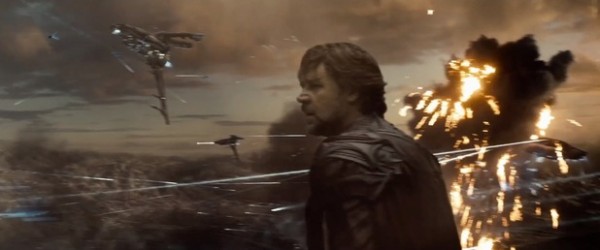
Body Count: 32 close-camera deaths — but I assume hundreds of thousands, if not millions of people cumulatively died during final battle. Think of the tsunamis the World Builder must have caused in the Indian Ocean!
Number of Times Superman Smugly Lets a Villain Shoot Him in the Chest: 0
Best Villain Dispatching: Superman’s overkill reprisal to the truck-stop asshole who poured a beer on his head, when the guy walks outside to discover that his semi-truck has mysteriously been turned into a Burning Man-esque piece of junk art.
Superman’s Superest Feat: I guess destroying the World Builder. That seemed hard.
Best Use of His Brains: He never really does anything particularly clever.
Should There Be a Sequel: Sure. If only because I’ll finally get the titan-of-industry version Lex Luthor I have been craving.
Franchise Assessment:
Superman is an odd character. Generally heroes are given a set-back for them to overcome, either emotional or physical or societal. Superman’s powers make him the ultimate alpha dog. He’s a god. He doesn’t really need to overcome anything. We shouldn’t be able to root for him. Yet his mission and purpose are so pure, selfless, and wholesome that we buy into him. Watching this whole franchise gave me a deeper appreciation for the character than I had before — when I preferred him as the square boy scout foil to Batman in the Justice League. But it is hard to deny the power of Superman when he is done right. I sort of pity filmmakers trying to work with the character in theatrical live-action films. He is the ultimate comicbook hero, which means his films need to be FX extravaganzas. Yet, if you’re staying true to the character he needs to be a little old-fashioned. The late 70s were the perfect time for a Superman movie, when Americans – weary from the dark reality of the decade – were primed for some post-war (meaning post WWII) nostalgia and good times. Supes doesn’t fit quite as easily into our current world, where Marvel has utilized their more relatable slate of heroes. Yet the character is so iconic I am still eager to see filmmakers take a stab at the franchise.
Installments ranked from best to worst:
Superman (1978)
Superman II
Superman Returns | Man of Steel
Superman (1948) | Atom Man vs Superman
Supergirl | Superman III
Superman IV: The Quest for Peace
Superman and the Mole Men
My perfect Superman franchise cast:
Superman — Christopher Reeve
Lois Lane — Noel Neill
Lex Luthor — Kevin Spacey
Perry White — Jackie Cooper
Jimmy Olsen — Sam Huntington
Jor-El — Marlon Brando
Ma Kent — Diane Lane
Pa Kent — Kevin Costner
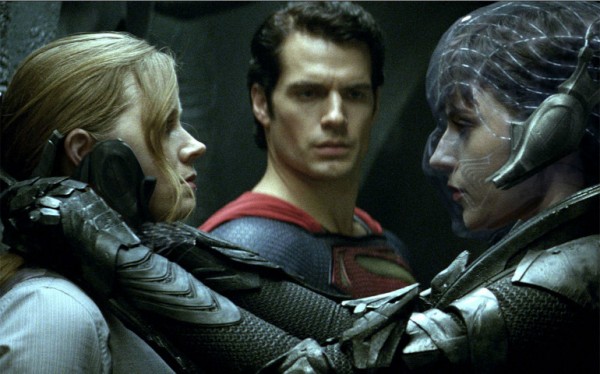
previous franchises battled
Alien
Back to the Future
Critters
Death Wish
Die Hard
Hellraiser
Home Alone
Jurassic Park
Lethal Weapon
Leprechaun
Meatballs
The Muppets
Phantasm
Planet of the Apes
Police Academy
Predator
Psycho
Rambo
Tremors